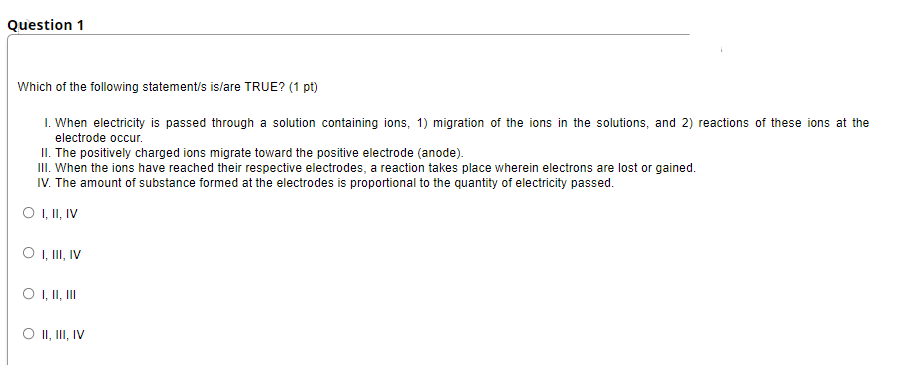Which of the following statement/s is/are TRUE? (1 pt) I. When electricity is passed through a solution containing ions, 1) migration of the ions in the solutions, and 2) reactions of these ions at the electrode occur. II. The positively charged ions migrate toward the positive electrode (anode). II. When the ions have reached their respective electrodes, a reaction takes place wherein electrons are lost or gained. IV. The amount of substance formed at the electrodes is proportional to the quantity of electricity passed. O , II, IV O , II, IV O I, I,II O II, II, IV
Which of the following statement/s is/are TRUE? (1 pt) I. When electricity is passed through a solution containing ions, 1) migration of the ions in the solutions, and 2) reactions of these ions at the electrode occur. II. The positively charged ions migrate toward the positive electrode (anode). II. When the ions have reached their respective electrodes, a reaction takes place wherein electrons are lost or gained. IV. The amount of substance formed at the electrodes is proportional to the quantity of electricity passed. O , II, IV O , II, IV O I, I,II O II, II, IV
Chemistry
10th Edition
ISBN:9781305957404
Author:Steven S. Zumdahl, Susan A. Zumdahl, Donald J. DeCoste
Publisher:Steven S. Zumdahl, Susan A. Zumdahl, Donald J. DeCoste
Chapter4: Types Of Chemical Reactions And Solution Stoichiometry
Section: Chapter Questions
Problem 19Q
Related questions
Question

Transcribed Image Text:Question 1
Which of the following statement/s is/are TRUE? (1 pt)
I. When electricity is passed through a solution containing ions, 1) migration of the ions in the solutions, and 2) reactions of these ions at the
electrode occur.
II. The positively charged ions migrate toward the positive electrode (anode).
II. When the ions have reached their respective electrodes, a reaction takes place wherein electrons are lost or gained.
IV. The amount of substance formed at the electrodes is proportional to the quantity of electricity passed.
O , I, IV
O , II, IV
O , I, II
O I, II, IV
Expert Solution
This question has been solved!
Explore an expertly crafted, step-by-step solution for a thorough understanding of key concepts.
Step by step
Solved in 2 steps

Knowledge Booster
Learn more about
Need a deep-dive on the concept behind this application? Look no further. Learn more about this topic, chemistry and related others by exploring similar questions and additional content below.Recommended textbooks for you

Chemistry
Chemistry
ISBN:
9781305957404
Author:
Steven S. Zumdahl, Susan A. Zumdahl, Donald J. DeCoste
Publisher:
Cengage Learning


Chemistry: An Atoms First Approach
Chemistry
ISBN:
9781305079243
Author:
Steven S. Zumdahl, Susan A. Zumdahl
Publisher:
Cengage Learning

Chemistry
Chemistry
ISBN:
9781305957404
Author:
Steven S. Zumdahl, Susan A. Zumdahl, Donald J. DeCoste
Publisher:
Cengage Learning


Chemistry: An Atoms First Approach
Chemistry
ISBN:
9781305079243
Author:
Steven S. Zumdahl, Susan A. Zumdahl
Publisher:
Cengage Learning

Introductory Chemistry: A Foundation
Chemistry
ISBN:
9781337399425
Author:
Steven S. Zumdahl, Donald J. DeCoste
Publisher:
Cengage Learning

Chemistry: The Molecular Science
Chemistry
ISBN:
9781285199047
Author:
John W. Moore, Conrad L. Stanitski
Publisher:
Cengage Learning

General Chemistry - Standalone book (MindTap Cour…
Chemistry
ISBN:
9781305580343
Author:
Steven D. Gammon, Ebbing, Darrell Ebbing, Steven D., Darrell; Gammon, Darrell Ebbing; Steven D. Gammon, Darrell D.; Gammon, Ebbing; Steven D. Gammon; Darrell
Publisher:
Cengage Learning